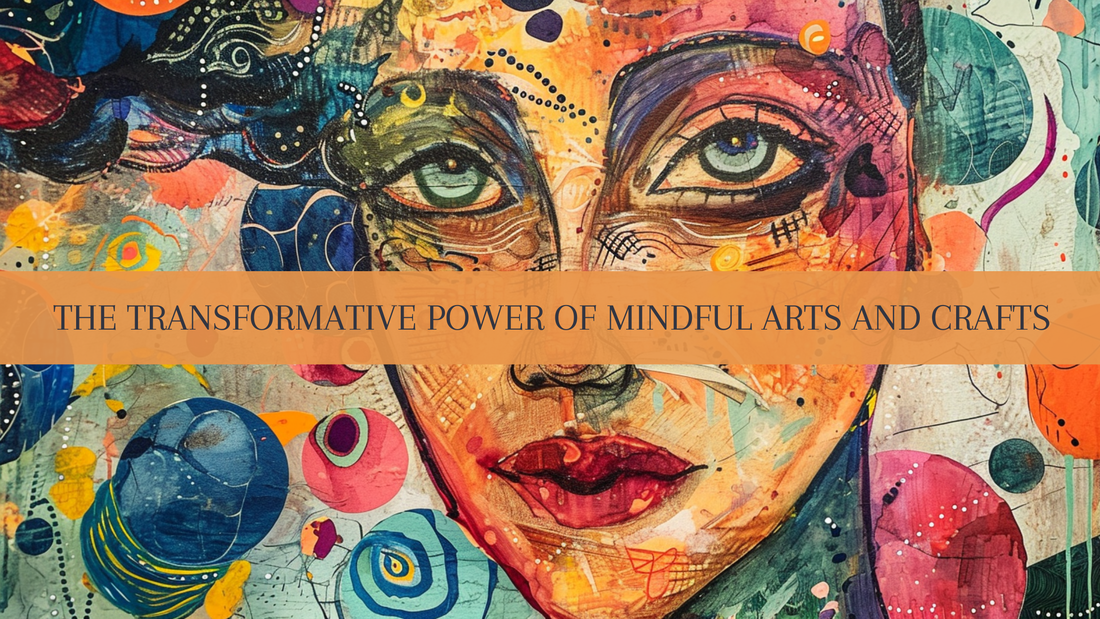|
Introduction Finding moments of peace and tranquillity can be challenging in a world where life seems to be constantly accelerating. This is where mindful arts and crafts practice emerges as a beacon of serenity and self-expression. Rooted in the principles of mindfulness, these activities offer a unique blend of creativity and meditative focus, providing a therapeutic escape from the stresses of daily life. What is Mindfulness in Arts and Crafts? At its core, mindfulness is about being fully present in the moment and aware of our thoughts and feelings without distraction or judgment. This approach transforms simple creative activities into powerful mental well-being and self-discovery tools when applied to arts and crafts. Deepening the Connection with the Self When engaging in mindful arts and crafts, the individual becomes deeply connected with their inner self. This connection fosters a heightened awareness of personal thoughts, emotions, and body sensations. As one paints, draws, or crafts, they become more attuned to their inner emotional states, often leading to insights and revelations about themselves that might otherwise remain unexplored. The Art of Mindful Observation Mindful arts and crafts teach the art of observation. Practitioners learn to observe their creative choices – the colours, textures, and forms they are drawn to – and reflect on what these choices reveal about their current state of mind. This reflection can be a powerful tool for self-understanding and emotional healing. Transforming Thoughts and Emotions into Art This approach allows individuals to channel their thoughts and emotions into something tangible. It’s a form of non-verbal communication with oneself, where emotions that are difficult to express in words find a voice through art. This process can be incredibly liberating and therapeutic, particularly for those dealing with stress, anxiety, or emotional blockages. The Meditative Quality of Creative Flow Arts and crafts, when performed mindfully, can lead to a state of 'flow' – a term coined by psychologist Mihaly Csikszentmihalyi. In this state, individuals become so immersed in their activity that they lose track of time and are entirely absorbed in the moment. This flow state has been linked to increased happiness, lower stress levels, and a sense of profound fulfilment. Fostering Mindfulness Skills Regular mindful arts and crafts practice can cultivate critical mindfulness skills such as concentration, attention to detail, and patience. As one becomes more practised in focusing on the task at hand, these skills can transfer to other areas of life, improving overall mental focus and clarity. The Role of Acceptance and Non-Judgment A critical aspect of mindfulness in arts and crafts is the practice of acceptance and non-judgment. This means accepting one's creative process as it is, without self-criticism or striving for perfection. It encourages embracing mistakes as part of the learning and growing process, fostering a kinder, more compassionate attitude towards oneself. In conclusion, mindfulness in arts and crafts is not just about creating art; it's a holistic practice that nurtures mental, emotional, and sometimes even spiritual well-being. It's an opportunity to connect deeply with oneself, express emotions creatively, and develop a mindful approach to life, one brushstroke at a time.
0 Comments
Embarking on a creative writing journey can feel like standing at a crossroads. You're bursting with ideas, overflowing with enthusiasm that rivals a caffeine overdose, and driven by a burning desire to breathe life into your stories. But the path ahead? It's like venturing into the unknown without a compass. Don't fret, though. In this article, I've crafted a short guiding light to help you navigate the captivating world of creative writing, igniting your confidence and creativity.
1. Find Your Inspiration:
2. Develop a Writing Routine:
3. Create Memorable Characters:
4. Craft Engaging Plots:
5. Edit and Revise:
6. Overcome Writer's Block:
7. Embrace Feedback:
8. Celebrate Your Achievements:
Creative writing is a rewarding endeavour that allows you to unleash your imagination and share stories that resonate with readers. Following these tips and staying dedicated to your craft, you can embark on a fulfilling creative writing journey and bring your stories to life. Monika Baechler-Dombay Creative Writer and Author Invisible Triumphs: A Journey Through the Mind
In the corners of the mind, there exists a vast expanse. A terrain of thoughts, emotions, memories, each carving its unique winding path, forming an intricate tapestry of human experience. These elements, woven together, constitute the essence of our being. Yet, there are threads darker than others, heavier, demanding attention, demanding to be felt. Mental health, a subject often left unspoken, hides within this rich tapestry. A silent struggle, it mirrors the depth of human resilience. This journey is one of peaks and valleys, filled with battles unseen, wounds untended, and victories uncelebrated. It is an inward journey that may appear lonely but far from solitary. To endure is to be human. To persevere is to defy the odds. Mental health is not a sign of weakness but a testament to strength. A struggle that reveals the raw power of endurance, the courage to continue, and the will to keep fighting. And in this struggle, there is an undeniable beauty. When faced with darkness, resilience becomes our beacon, guiding us through the turbulent sea of fear, anxiety, depression. Each wave faced, and storm weathered contributes to shaping our existence, an ode to survival, a homage to never giving up. Despite the hardships, we must remember that there is always a dawn following the darkest night, a calm after the most devastating storm. The world within our minds can be both our greatest enemy and our most powerful ally. The key lies in understanding, accepting, and nurturing it. This narrative is for the brave, those who refuse to be defined by their struggles. It is a call to embrace the journey, recognize the power within, rise above, persist, and never give up. Mona Bee By now, two warm candles are glowing on the wreath. Pure delight, the first snow of the season has fallen, and the world is transformed into a winter wonderland. The snow-covered hills and trees sparkle in the sunlight, and the air is crisp and fresh. I can hear the cheerful squeals of children sledging down the slopes and the crunch of the snow beneath my feet as I walk. The snow feels cold and soft against my skin, and the air smells clean and refreshing. It's a magical time filled with the season's joy and nature's beauty. - Monika Baechler
Imagine a government that uses AI-driven technology to ensure its policies are as effective, efficient and transparent as possible. This would be great for all of us! But how do we get to this point? What does the future look like for AI-governance? And how can we ensure that it's done in the best interests of everyone?
Benefits of AI-Technology
If you have ever wondered what our daily lives will look like when the government is run by AI technology, this article is for you. AI-driven government promises a more efficient and effective administration with less human error and bias. In addition to processing and analyzing large amounts of data faster than humans, AI systems can also make better decisions without fatigue or emotion. Moreover, since machines do not have emotions or political agendas, they won't be influenced by lobbyists or self-interest groups like politicians – making them ideal leaders for any organization that needs objective decision-making skills to succeed (and survive). Who gets to control the algorithm? AI is not a black box, but it is also not transparent. The government needs to be able to explain and justify its decisions, even if that means exposing some things AI can't do well. But seriously, who gets to decide what data is used and how it is used? Who gets to decide what the AI does? Who gets to decide what the AI learns? Who gets to decide what the AI does not learn? These questions may seem trivial in an era where we have become accustomed to trusting our devices with all kinds of personal information about us; however, this complacency obscures important distinctions between government and private-sector use of AI. For example, when Facebook uses algorithms for advertising, you can generally expect that your data will be used toward specific commercial ends. Still, if Facebook were developing a policy making algorithm for use by state agencies or local municipalities, our concerns would need more thorough investigation than they currently enjoy. The danger here is obvious: If too much power over public decision-making were concentrated in private corporations whose goals are driven more by profit than civic responsibility, then those corporations could easily abuse their position by manipulating public opinion through targeted advertising campaigns aimed at vulnerable demographics. The challenges of AI With the possibility of AI being used in the government, it's essential to understand that AI is a tool, not a solution. It can be used for good or evil. In this section, we'll talk about why AI isn't here yet and what challenges still need to be overcome before it becomes mainstream. AI is not a substitute for human decision-making. While AI has been around since the 1950s and was popularized by science fiction movies like 2001: A Space Odyssey in 1968, many challenges must be addressed before true artificial intelligence (AI) technology becomes mainstream. For example, computers don't always make better decisions than humans—they are only as smart as their programming allows them! People's skills need to evolve with the technology! As you see, AI technology is becoming more and more prevalent in our daily lives. However, it's essential to understand that for this to happen; it will be imperative for people's skillsets to evolve with the technology. For example: People need to learn new skills like how to trust AI. They also need to learn how to understand what it does (i.e., its capabilities) and how it thinks (i.e., its algorithms). We'll need these fundamental things as we begin using more advanced systems. People will also need a basic understanding of computer science so they can control their data and ensure it is appropriately used by the system(s). This means being able to read code! Governments will have to work on building trust in AI's plans. To build trust, governments must be transparent with their plans and explain what AI can do. People need to understand how it can help everyday life and how it can also be used for destructive purposes. Governments should ensure people are aware of both sides of the coin to make more informed decisions about using AI technology daily. Conclusion Governments have a lot of work ahead of them if they want to implement AI technology successfully. But we believe it will be worth the effort. The potential for AI-driven government is vast: it can make our lives better and more efficient while respecting human rights and freedom. Written by AI Edited by Monika Baechler |
AuthorMona is a versatile writer with experience in both fiction and non-fiction. She deeply loves the written word and is always seeking new and exciting ways to explore the human experience through her writing. Archives
January 2024
Categories
All
|





 RSS Feed
RSS Feed